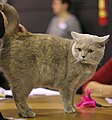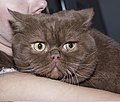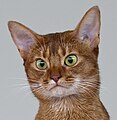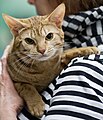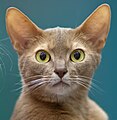Rare cat colour overview
Attention
[edit]- All coat colours can occur as tortoiseshells. In these coats the base colour (black-brown, chocolate, cinnamon) is mixed with red-orange tabby parts, or cream tabby parts for diluted colourations (blue, lilac, fawn).
- Solid white areas can be mixed with all tabby coats. On paws the white areas will result in pink footpads, white areas around the muzzle will turn the nose pink-red. Similar to solid-white cats. See also: Tabby and white cats.
- All coat colours can occur in combination with the silver or golden genes (see also Silver and golden cats for examples), which presents as effects on the pigment colouration at the base/root of each hair rather than a separate colour. The tip of the hairs will still have the main coat colours.
- These type of rare colours and colour dilutions are more likely to appear in pedigree or purebred cats that have been specifically bred for their colouration. See also Tabby cat colour overview for more common coat colours.
- The colours can present differently in different breeds and in colourpoint markings.
- Kittens can have lighter or different colourings and/or faint tabby patterns, because the coat is not fully developed yet.
- Ambient light can influence the appearance of the coat colouration in pictures. Additionally, sunlight can lighten the fur pigmentation.
Chocolate cats
[edit]Chocolate cats (sometimes in US English “champagne”) have a warm chocolate brown coloured solid coat or tabby markings. The paw pads and nose leather are cinnamon-pink to chocolate brown in colour. Lilac is the diluted (lighter) version of chocolate.
Attention: Sometimes black cat fur is mistaken with chocolate, especially if the pigmentation is lightened by sunlight or tyrosine deficiency. Generally, black cats will have black coloured paw pads and nose leathers, while these are cinnamon-pink to chocolate-brown coloured in chocolate cats.
-
Kitten footpad
-
Kitten footpad
-
Nose leather and whiskers
-
Solid
-
Solid
-
Solid
-
Solid
-
Solid
-
Solid kitten
-
Solid
-
Solid smoke
-
Tabby
-
Tabby
-
Tabby
-
Tabby
-
Tabby (right cat)
-
Tabby
-
Sepia
-
Sepia
-
Mink
-
Chocolate silver shaded
-
Silver tabby and white
Lilac cats
[edit]Lilac cats (also called lavender or in US English “platinum”) have pale grey/warm lavender with a pinkish tint coloured coats. The nose leather and paw pads are lavender pink / pinkish-grey / mauve coloured. Lilac is the diluted (lighter) version of chocolate, and it's considered one the rarest cat colours.
Solid, tabby and tortoiseshell
[edit]-
Kitten
-
Solid, BSH kitten
-
Solid, BSH
-
Solid, BSH
-
Solid, BSH
-
Solid
-
Ticked tabby, SOM
-
Lilac silver ticked tabby, SOM
-
Tabby
-
Tabby, BSH
-
Tabby
-
Tabby (left cat), OCI
-
Spotted tabby, OCI
-
Spotted tabby, OCI
-
Spotted tabby, OSH
-
Tabby, ACS
-
Tortoiseshell and white, OSH
-
Tortoiseshell, BSH
Lilac colourpoint
[edit]-
Footpad
-
Mink, TON
-
Mink, TON kitten
-
Sepia
-
Sepia kitten
-
Colourpoint
-
Colourpoint
-
Colourpoint and white
-
Colourpoint and white
-
Tabby point
-
Tabby point
Cinnamon cats
[edit]Cinnamon cats coloured cat coats, also called sorrel some breeds. Cinnamon is a warm light reddish-brown colour. The cat’s nose leather is cinnamon-brown and the paw pads go from cinnamon-brown to pinkish tan. Cinnamon is lighter than chocolate, and should not be confused with red or black tortoiseshell tabby (which also have black tabby markings).
-
Nose leather, ABY
-
Nose leather, ABY
-
Kitten footpads: cinnamon silver tabby (l) and cinnamon silver sepia (r), ASN
-
Cinnamon tabby (l) and cinnamon silver tabby (r), ASN
-
Cinnamon tabby (l) and cinnamon silver tabby (r), ASN
-
Cinnamon tabby (b) and cinnamon silver tabby (t), ASN
-
Solid, BSH (not chocolate, notice nose leather)
-
Solid, BSH kitten
-
Bicolour, BSH
-
Ambient light effect
-
Ticked tabby, ABY
-
Ticked tabby, ABY
-
Ticked tabby, ABY
-
Ticked tabby, ABY
-
Ticked tabby, SOM
-
Ticked tabby, SOM
-
Ticked tabby, SOM
-
Ticked tabby, SOM
-
Silver ticked tabby, SOM
-
Ticked tabby, ASN
-
Tabby, ASN
-
Tabby kitten, ASN
-
Tabby kitten, ASN
-
Spotted tabby, OCI
-
Silver spotted tabby, OCI
Fawn cats
[edit]Fawn cats have a warm rose pinkish beige coat. The cat’s nose leather and paw pads is pinkish tan. Fawn is the diluted (lighter) version of cinnamon, and it's considered one the rarest cat colours. Fawn is very rare, but most commonly seen in breeds like the Abyssinian (ABY), Somali (SOM), British Shorthair (BSH) or Oriental Shorthair (OSH). Fawn is often confused with cream and red/orange.
-
Bicolour, BSH
-
Solid, BSH
-
Tabby, BSH kitten
-
Ticked tabby, SOM
-
Ticked tabby, ABY
-
Ticked tabby, ABY
-
Ticked tabby, ABY
-
Ticked tabby, ABY
-
Ticked tabby, ABY
-
Fawn silver, ABY
Amber cats
[edit]Cats with amber coats are genetically different from cats with red or black-brown coats. Amber cats are born with a similar appearance as black-brown tabbies, but grow up looking like red tabbies. This colour is only found in Norwegian Forest Cats.
- Amber colouration change from kitten to adult
-
8 months (l) vs 3 years (r) old amber cats








































